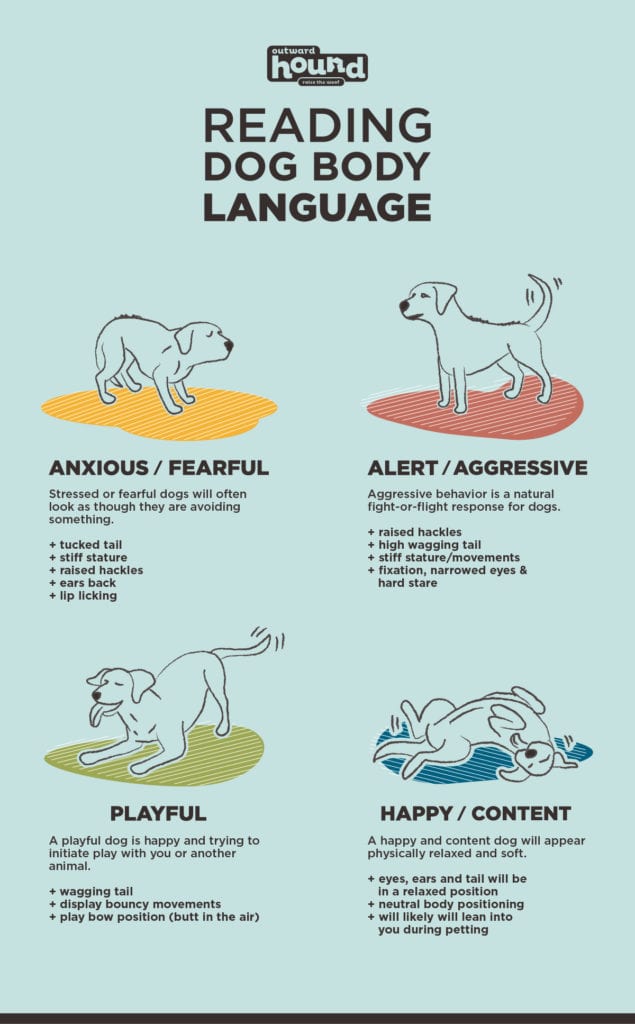We all love dogs, but we aren’t always good at understanding what they think and how they are feeling. When trying to understand people, non-verbal communication is just part of understanding someone, but with our canine best friends, body language is everything. All humans can benefit from knowing how to read dog body language in order to understand how dogs communicate.
Understanding dog body language includes looking at a body posture as well as facial expressions. This will help you gain a deeper understanding of a dog’s emotional state as well as overall comfort.
For example, popular viral videos and pictures of dogs on social media often show dogs whose eyes are open very wide, or who are looking awkward while children lay on them. To the untrained eye, these pictures might look cute. Once you are familiar with canine body language, however, you’ll quickly realize how uncomfortable and stressed the dogs are.
Becoming fluent in canine body language can also help you to be a better advocate for your dog in a variety of situations like greeting other dogs, meeting new people, or even visits to the vet.
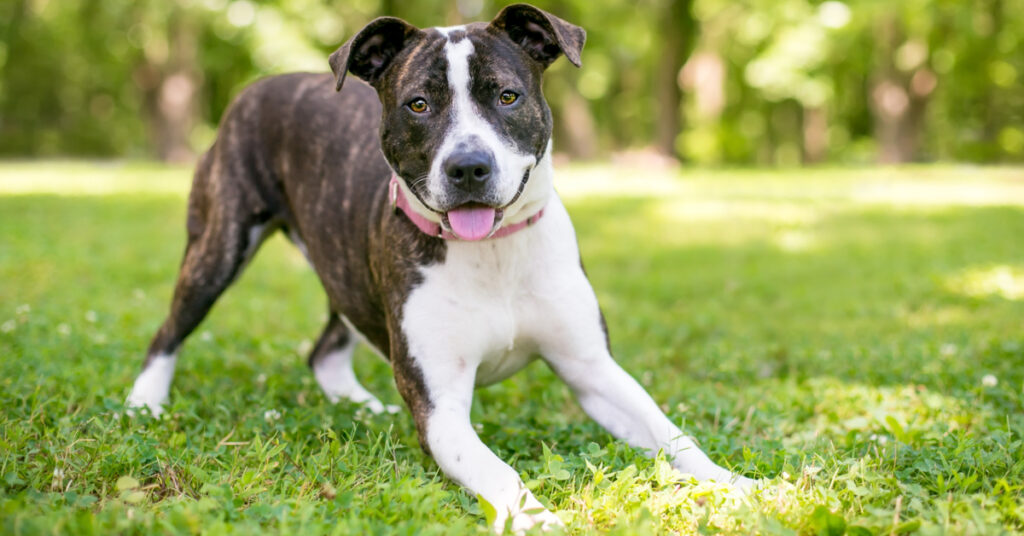
Reading Dog Body Language
To get a full understanding of what a dog is communicating through its body language, you need to look at a dog’s entire body from mouth to tail — including eye contact.
A wagging tail might mean a dog is happy like most people assume. However, tail-wagging can actually mean a variety of things ranging from happy to agitated. As such, it’s important to look at the dog’s overall posture and body movements before assigning meaning.
We all know a wide wagging tail wag that extends through the whole body, combined with the dog’s face being relaxed, means a dog is happy. A tight swishing tail wag, however, can be a sign of stress. A stiff wag, when accompanied by hard starting and/or a tense, tight face and body, actually means that dog is very agitated and aroused. Depending on the dog and the situation, this could escalate into an aggressive incident.
Stressed / Scared Dogs
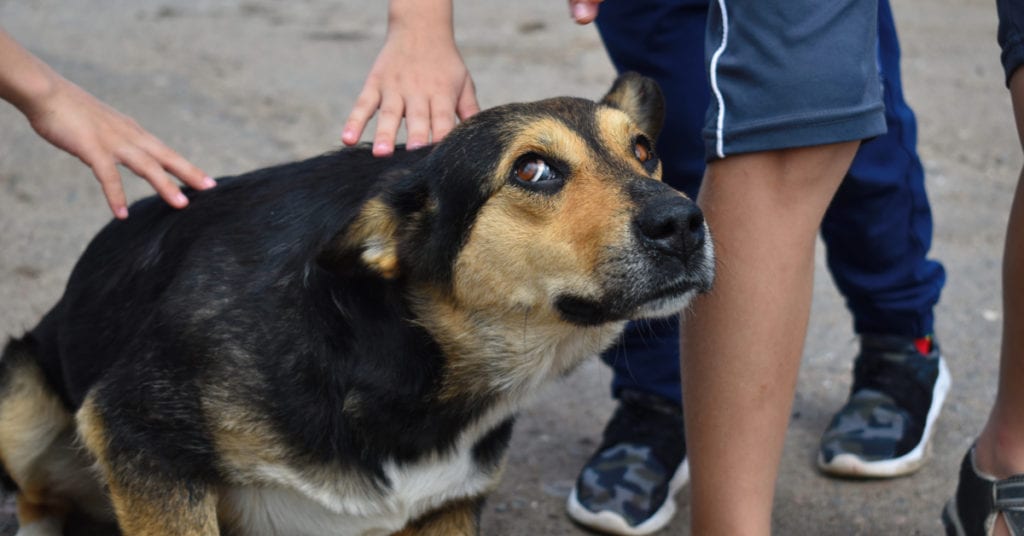
Dogs who are stressed or fearful will often look as though they are avoiding something. These dogs may turn their head away, avoid looking at you or whatever is upsetting. They may also deflect or self-soothe by suddenly becoming very interested in sniffing the ground.
Dogs who are feeling uncertain or anxious about a situation may also randomly begin scratching or licking themselves. Scared, stressed, or anxious dogs may pace, cower, shake or tremble.
People may mistake a dog rolling over as asking for a belly rub. In reality, they may be very afraid. At this point, some dogs will involuntarily urinate, attempt to hide behind their person or try to escape the situation.
A scared or stressed dog may yawn frequently and round its back cowering almost into a ball. They may flatten their ears back against their head, and their tail may also be tucked tightly up between their rear legs. A tense and still body that isn’t followed by play is another physical indicator that your dog may be concerned.
A fearful dog may respond by licking its lips often or drooling and panting when it’s not hot out. This is often accompanied by pinned ears, a tense or tight face, and what is referred to as “whale eye.” When your dog’s eyes are making a whale eye, their pupils are very dilated and bulging with lots of white showing.
Zoomies don’t always equal joy
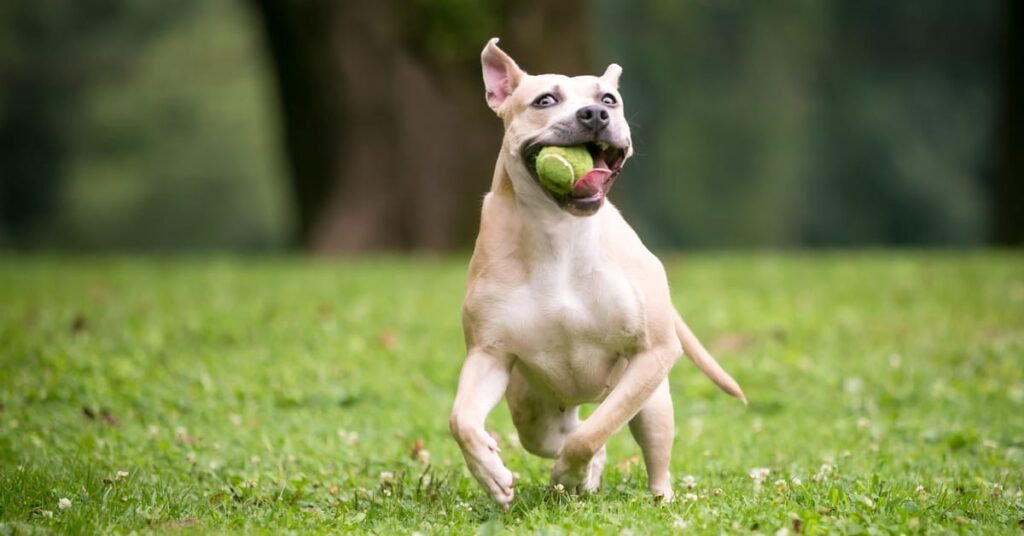
Some dogs get very hyperactive when they have been stressed and might start running erratically. Also known as getting the “zoomies,” it’s as a way of blowing off that stored-up stress.
These excited dogs may look like they are having a great time, but they may be overwhelmed and trying to defuse or avoid the situation that is making them feel uncomfortable.
Dogs who are feeling stressed are also likely to shake all over even though they aren’t wet. This is a way of calming down or refocusing when a stressful situation is over. Lip licking and yawning are common calming signals, ways that dogs will attempt to self-soothe in stressful situations.
Content & Happy Dogs
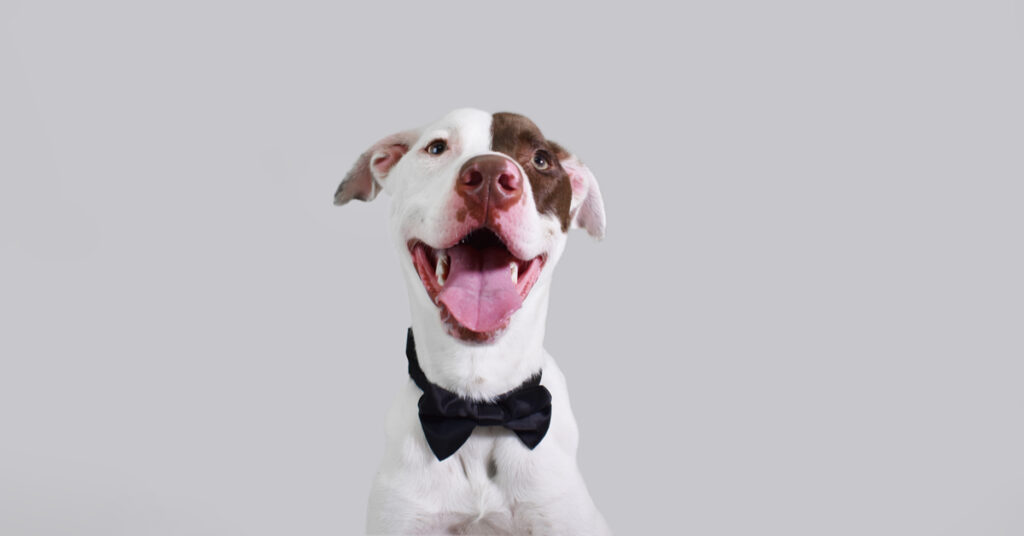
When you see a happy dog you are going to be looking at an overall relaxed body position and posture. A happy and content dog will appear physically relaxed and soft. A happy dog’s ears will be in a relaxed position. (This will differ depending on the dog’s breed and natural ear position.)
A play bow, where a dog lowers their front end until elbows are on the ground, tail wagging, and butt in the air, is a good sign that a dog is happy and trying to initiate play with you or another animal.
Dogs who are playing with each other or with you will often display bouncy movements. If two (or more) dogs are playing together and exhibit loud growls, barks, or even mouthing, the dog’s overall body language is soft and no one is getting hurt.
Dogs playing well together will be reading each other’s body language closely. They’ll also tend to switch between who is chasing and who is being chased. They will naturally take breaks before initiating play again.
When happy, the dog’s ears will be relaxed, not pressed back against the head. For example, a retriever’s relaxed floppy ears look different from a husky’s relaxed prick ears; but overall, when understanding if a dog is comfortable, we are looking for a generally neutral position.
When content and happy, a dog’s tail, mouth, eyes, and ears will all appear to be relaxed. Happy dogs may be observing the world around them, but don’t appear to be hyper-focused. Additionally, no part of their body will appear tense.
Similarly, when a dog is feeling content, the relaxed dog will likely lean into you during petting.
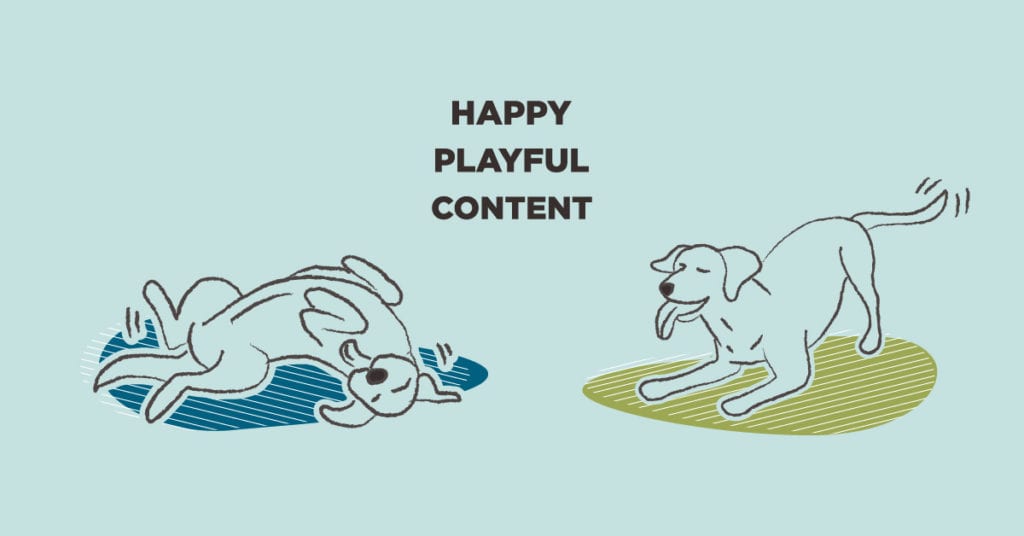
Aggression Looks Like
Aggressive dog behaviour is a complicated topic with a variety of underlying causes. It is a sign of fear. Aggression is a natural fight-or-flight act for dogs who feel they have no other alternative way to respond. It doesn’t mean that they are bad or inherently violent.
Aggressive behavior is generally the result of a dog being put into a position that is overwhelming, scary, or otherwise uncomfortable for them.
Additionally, no dog breed is inherently aggressive. Individual breed traits may influence reactions — some breeds are inherently more driven to chase prey, guard livestock, herd, or be all around sociable with strangers — but no breed of dog is inherently aggressive.
Signs of aggression, or that aggressive behavior could happen, are because the dog is agitated or uncomfortable. It stems from fear. Body language to be aware of includes:
- a high wagging tail accompanied by stiff movements
- narrowed eyes
- hard stare
- raised hackles
- weight shifted back
This can mean the dog is upset and likely to react aggressively if it isn’t given a way out of the situation they find upsetting.
Similarly, a dog whose weight has shifted back and is lunging forward may be a sign the dog is uncomfortable, which could escalate.
Dogs who are about to behave aggressively are likely to be hard starting and fixated. These dogs may be growling as a means of warning, and have their teeth bared and lips curled. A dog’s hackles (the hair on the back of its neck and back) may be raised, also known as piloerection.
For many dogs, this happens automatically when aroused, similar to how people might get goosebumps. Although raised hackles are a symptom of a dog being highly aroused, raised hackles alone don’t necessarily mean that a dog is going to behave aggressively.

Resources for learning more about how to read dog body language
When looking at canine body language, keep in mind that a dog’s breed and physical structure will shift the way they can use their body to communicate. For example, a pug has a tail that is naturally tightly coiled over the back when it is relaxed. Another breed like a beagle has a naturally lower tail set. A beagle would likely show he is feeling aroused and alert with a tail held high over the back.
Dogs are experts at reading each other’s body language and it’s a primary way that they understand interactions with other dogs.
By learning more about dog body language, you’ll be able to support your own dog by understanding more about what they are experiencing about the world around you.
One of the best ways to learn about body language is to work with a trainer who utilizes positive reinforcement methods. A dog trainer will be able to help translate your dog’s body language. They can help you to develop your own skills with understanding what your dog is trying to communicate through their posture and behavior.
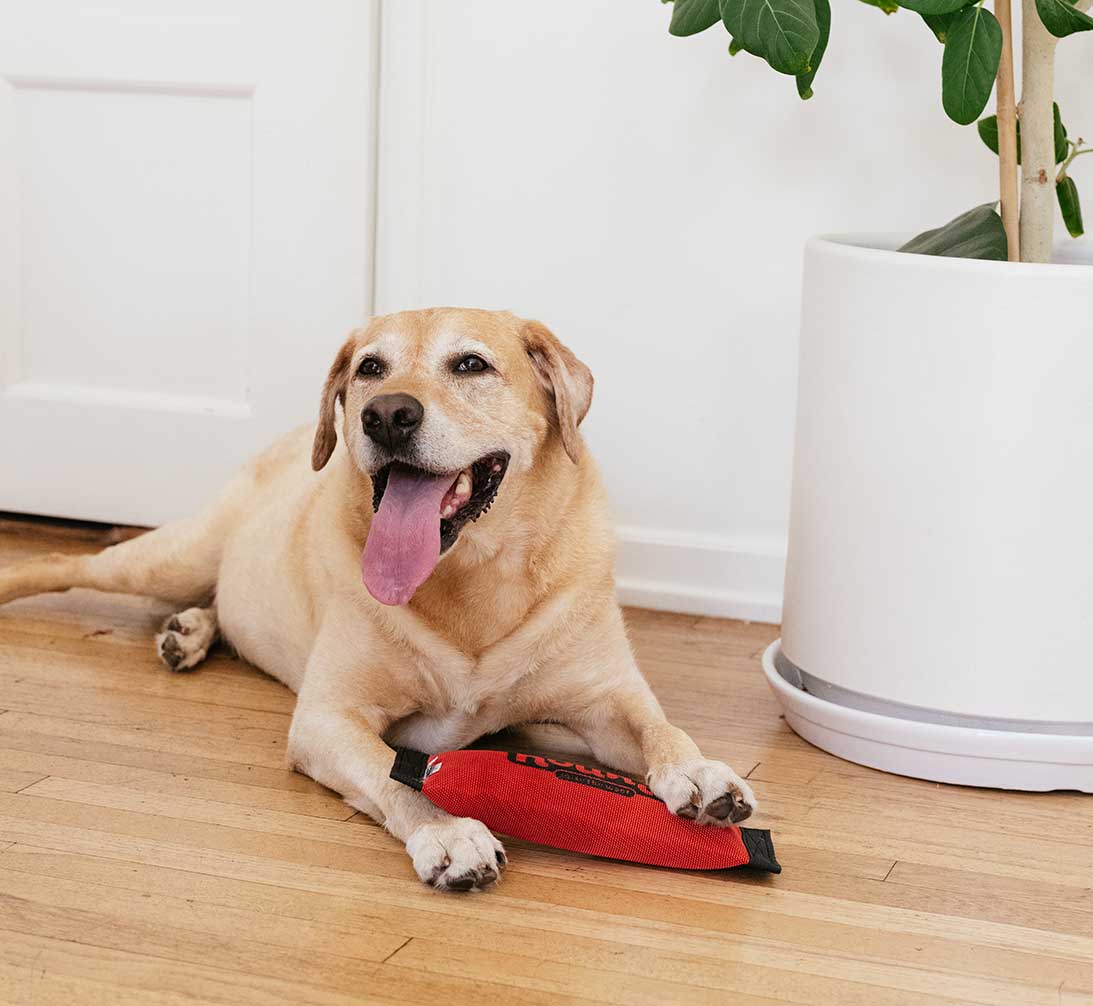
Books & Apps
Illustrator Lili Chin of Doggie Drawings has written and illustrated an amazing visual guidebook for understanding canine body language.
The book “On Talking Terms With Dogs Calming Signals” by Turid Rugaas, a Norwegian dog trainer, is an excellent resource for gaining a deeper understanding of the ways dogs might be trying to communicate they are stressed, and the ways that dogs self-soothe.
If you’re a dog owner looking for body language tips on the go, the Dog Decoder App is available for Android and iOS. The app lets you look up different dog body language behaviors and their meanings anywhere. There are even quizzes built into the app if you want to test your knowledge.
Be An Advocate for Your Dog
Unlike for our dogs, canine body language doesn’t come naturally to us. Learning canine communication is an ongoing process. Putting in the work to learn their natural body language can help us to better care for and advocate for not just our dogs, but all dogs.
Need to refer to a dog body language chart to understand your canine companion better? We got you.
